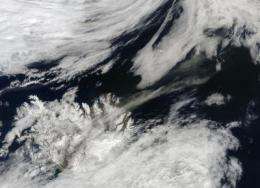NASA's Terra sees ash plume pulled to the northeast by a low

NASA's Terra satellite continues to provide visible and infrared imagery of Iceland's Eyjafjallajokull Volcano ash plume, and the most recent imagery showed the plume being pulled in a northeasterly direction over the island nation.
The brownish ash plume was being pushed to the northeast from a low pressure area situated to Iceland's northeast. The Moderate Resolution Imaging Spectroradiometer or MODIS instrument that flies aboard Terra captured an image on May 18 at 12:20 UTC (8:20 a.m. EDT).
NASA works with other agencies on using satellite observations to aid in the detection and monitoring of aviation hazards caused by volcanic ash.
As weather systems to continue to interact with the ash plume, it will continue to shift, so air travel may always be affected.
More information: For more on this NASA program, visit: .
Provided by NASA's Goddard Space Flight Center




















